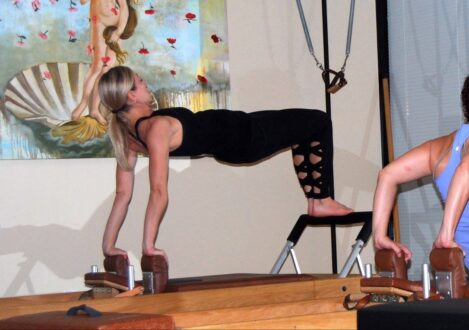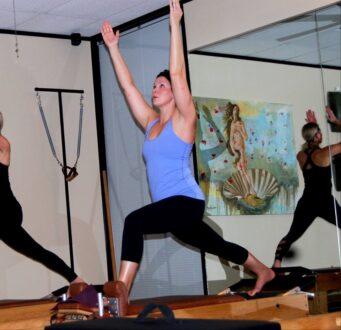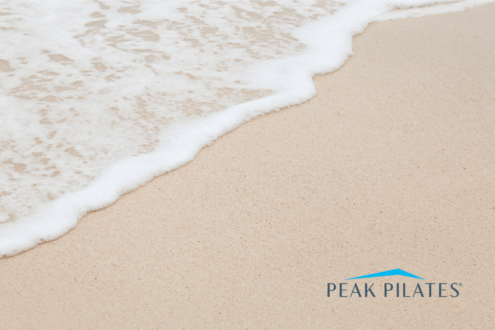By Zoey Trap, MS
It’s National Yoga Month! Celebrate. What???? This is a Pilates company! Peak Pilates® believes in movement in all forms to keep a body happy and healthy, and we believe that no single modality has all the answers. That’s one of the reasons we launched the FitCore™ Certification Program…it provided us with an avenue to offer a high-caliber fusion program that blends Pilates, yoga, fitness, barre, and other modalities seamlessly and intelligently for those wanting everything in one workout!
We believe that it’s not Pilates or Yoga, but that it can be Pilates and Yoga. Let’s examine some of the similarities and differences between the practices. Since there are many types of Pilates and Yoga, for our purposes we are comparing Classical Pilates with Vinyasa Yoga, as we believe they are the most similar. The chart below captures the main points of each and how they are different and where they overlap.
| Classical Pilates | Both | Vinyasa Yoga |
| A Modern Practice | An Ancient Practice | |
| Pilates Principles | Yamas/ Niyamas | |
| Set orders for levels on mat/ reformer | Progressive and adaptable to meet students at their level | Classes usually include traditional sequences of Sun Salutations as well as creative vinyasa flows sequenced by the instructor |
| Mindful Movement | Benefits in Stress Reduction | Moving Meditation |
| Core Strengthening | Improved Posture | Balance |
| Exercises in a variety of body positions and relationships to gravity-
Builds from supine to standing during a session |
Increases in Stability, Strength, Flexibility, Stamina | Asanas offer a wide variety of body positions with multiple joint angles
More standing work than in Pilates. |
| Focus on Exhalation | Enhanced Breath Awareness & Control | Ujayi Breath and Pranayama practices |
| Injury Prevention and Rehabilitation | Elevated Sense of Well-Being | Yoga Therapy for Mind & Body |
| Mat and/or Props, and/or Spring-Loaded Equipment to provide assistance, resistance | Props: Bricks, yoga straps, wedges, blankets, bolsters | |
| One breath, one movement | Sun Salutations and flow sequences often are one breath one movement. Classes typically have held postures of anywhere from 3- 20 breaths. |
Each practice, while distinctly different from the other, affords the student an avenue to grow in mindfulness and progress in physical and mental skills. Yoga includes much more standing work than does Pilates and chaturangas (similar to push-ups) are usually woven throughout the class in linking sequences.
The greatest difference is that yoga is inherently intended to be a spiritual practice, and most sessions include meditation and chanting. Of course, this can be school and instructor dependent.
While there is a different vocabulary or language to each practice, there is also much overlap. What we call centerline, a yogi calls midline; what we call length and opposition, they call lines of energy; what we call activating the powerhouse, they refer to as mulabandha or uddiyana bandha… and the list goes on.
A good instructor of either modality corrects alignment, provides physical assists, inspires, and progresses students wisely. All good instructors stay committed to advancing their skills through practice, lessons, and continuing education. While yoga is most often taught in group classes, it can be taught to great benefit privately. Pilates is taught both through private and group classes. Some students are group lovers and never take privates, while others only take privates, and some mix it up.
Want to learn more? We will be holding a workshop that will provide the Pilates instructor with an opportunity to explore a yoga practice on the reformer. This is not a fusion or a Pilates class with yoga mixed in. Pure and simple, it is a yoga class delivered on reformers with carriages in motion. Whether you practice yoga or not, your students might. And you might wish to attract yoga students to your studio and want to understand the demands of their practice. We will spend 3 hours exploring the similarities of language, alignment concepts, shapes, and approaching yoga asana first on a mat and then on the reformer.
Amanda Meehan who recently took this class shares: “Yoga on the reformer was both fun and incredibly eye-opening. It gave me a deeper understanding of my Yoga practice like I’ve never experienced before—and I’ve been practicing for over 25 years. After the class, my body felt strong and aligned for days. The session was challenging yet playful, making it an enjoyable and rewarding experience.” We hope you will feel the same!
Yoga on the Reformer – Virtual Workshop
When: Friday, September 27, 2024 | 2:00-5:00 pm Eastern
Who: Zoey Trap is a Master Instructor as well as the Executive Director of Peak Pilates® Education and Training and a Certified Jivamukti Yoga Instructor. Zoey began practicing Yoga 35 years ago and took up Pilates shortly thereafter. She knows first-hand how complimentary these practices can be! Zoey was a pioneer in fusing yoga and Pilates on mat and equipment.
USA/Canada/Asia Registration: https://peakpilates.com/yoga-on-the-reformer-virtual-workshop-september-27-2024/





